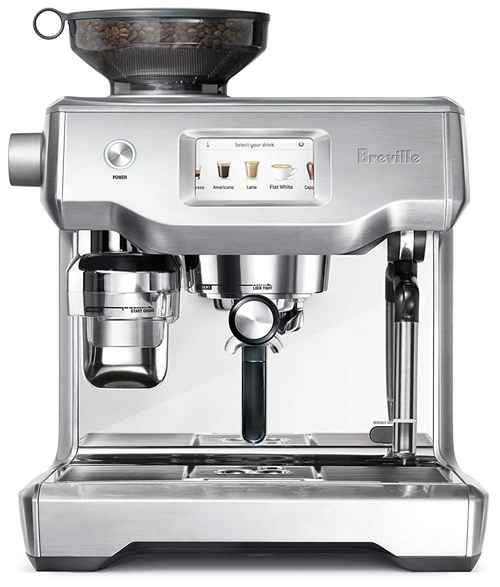Latte Espresso Machine Recipe [+Tips]
Note: This page contains affiliate links.
As an Amazon Associate, I earn from qualifying purchases when you click on the link, but you are not charged extra.
Let’s just pause for a second and imagine: it’s a chilly morning, your kitchen smells like fresh espresso, and your hands are wrapped around a warm, creamy mug of latte. That gentle whoosh of steamed milk, that deep, bold shot of espresso, and the soothing swirl of foam on top-it’s not just a drink; it’s a moment.
- Old World Christmas Beans: Tastes like the holidays in every cup — discover the cozy magic of Old World Christmas Beans before the season slips away.
- Kirkland Sumatra French Roast : Dark, bold, and wildly smooth—why Kirkland’s Sumatra French Roast is the best-kept secret of serious coffee drinkers.
- Hot Fudge Whole Bean Coffee : What happens when dessert meets coffee? Meet the decadent whole bean that tastes like hot fudge—but better.
- Aroma Ridge Guatemala Antigua Medium Roast : From the highlands of Guatemala to your morning mug—this rich, balanced roast is waking up coffee lovers everywhere.
- Juan Valdez Cumbre Colombian Coffee : Crafted by Colombia’s most iconic coffee legend—why Cumbre is a must-try for fans of bold, authentic flavor.
A latte (short for caffè latte, which means ’milk coffee’ in Italian) is the lovely lovechild of robust espresso and creamy steamed milk. And while cafés do a bang-up job with it, you can absolutely master this at home-especially if you’ve got an espresso machine. And no, you don’t need to be a trained barista. With a little guidance (that’s where I come in!), you’ll be making lattes that will make your local café barista nervous.
Contents
- 1 Ingredients For Latte Espresso Machine Recipe
- 2 How To Make A Latte With An Espresso Machine
- 3 Expert Tips
- 4 Recipe Variations
- 5 Final Words
- 6 FAQs
- 6.1 What Is The Basic Recipe For Making A Latte Using An Espresso Machine?
- 6.2 How Much Espresso Do I Need For A Single Latte?
- 6.3 What Is The Ideal Milk-to-espresso Ratio For A Latte?
- 6.4 How Do I Make The Perfect Steamed Milk For My Latte?
- 6.5 Can I Use Non-dairy Milk For A Latte? Does It Change The Recipe?
- 6.6 How Can I Make My Latte Stronger?
- 6.7 What Temperature Should I Steam Milk To For A Latte?
- 6.8 Can I Add Flavored Syrups To My Latte?
- 6.9 What’s The Best Espresso Machine For Making Lattes At Home?
- 6.10 How Do I Avoid Separating Milk In My Latte?
Ingredients For Latte Espresso Machine Recipe
Now before we start frothing and pulling espresso shots like pros, let’s get our ingredients in order. Simple, yes. But quality? That’s where the magic begins.
What You’ll Need
- Espresso beans – Freshly roasted if possible! Go for medium to dark roast for that rich, robust flavor.
- Filtered water – Yes, this matters. Good water = good espresso.
-
Milk – Whole milk gives the creamiest results, but you can also use:
- 2% milk (slightly lighter but still good)
- Oat milk (amazing froth, subtle sweetness)
- Almond milk (nutty and light, but choose barista blend for better foam)
- Soy milk (solid choice, nice texture)
-
Optional Extras
- Sugar or sweeteners
- Vanilla extract or syrup
- Caramel drizzle
- Cinnamon or cocoa powder for garnish
✨ Pro Tip: The fresher your espresso beans, the better your shot will taste. If they’ve been sitting around for months, you’ll taste it-and not in a good way.
How To Make A Latte With An Espresso Machine
Okay! Let’s roll up those sleeves and get into it. The whole process only takes a few minutes, but each step has its little tricks and finesse. Here’s your barista breakdown:
Grind Your Beans
- Use a burr grinder for consistent grind size.
- Aim for a fine grind, but not powdery-like table salt.
- You’ll need about 18-20 grams of espresso for a double shot.
Pull Your Espresso Shot
- Load the portafilter, tamp it evenly with firm pressure.
-
Lock it into the machine and pull a double shot.
- It should take 25-30 seconds for the shot to extract.
- The espresso should look rich, with a nice crema (that golden foam on top).
Steam Your Milk
- Pour cold milk into your metal frothing pitcher (fill only to the bottom of the spout).
- Insert the steam wand just below the surface of the milk.
- Turn on the steam and listen for that signature hisssss-you’re stretching the milk and creating microfoam.
-
Once it starts to feel warm (about 100°F), submerge the wand deeper and continue heating until it reaches between 140-155°F.
- Do NOT overheat or you’ll scorch the milk.
- The texture should be velvety, not bubbly.
Combine And Pour
- Swirl the milk in the pitcher to integrate the foam and liquid.
- Pour the steamed milk into your cup of espresso slowly.
- For fun, try your hand at some latte art-hearts, rosettas, even just a cute swirl counts!
Expert Tips
Let’s talk strategy. Here are some golden rules and game-changing tricks that will take your latte from ’meh’ to ’masterpiece’:
- Use preheated cups – Keeps your drink hot longer and maintains that silky texture.
- Purge your steam wand before and after use – This clears out old milk and water buildup.
- Don’t skip the tamp – Uneven tamping means uneven extraction. Press firmly and evenly.
- Frothing milk is all about sound – That gentle paper-tearing sound? That’s the sweet spot.
- Clean as you go – Dried milk on a steam wand is the enemy. Wipe it down immediately.
Recipe Variations
Here’s where you get to play! Once you’ve nailed the classic latte, you can jazz it up in so many ways. Let’s explore:
Seasonal Favorites
- Pumpkin Spice Latte – Add a teaspoon of pumpkin purée + pumpkin pie spice + dash of vanilla.
- Gingerbread Latte – Ginger, cinnamon, molasses, and a festive mood.
Dessert-Inspired
- Mocha Latte – Add a tablespoon of chocolate syrup or cocoa powder to the espresso before pouring in the milk.
- Salted Caramel Latte – Caramel syrup + pinch of sea salt. Heaven.
Plant-Based Perfection
- Oatmilk Honey Latte – Creamy oat milk + a drizzle of honey = cozy and subtly sweet.
- Almond Vanilla Latte – Almond milk with a splash of vanilla extract or syrup.
Iced Latte Twist (Bonus!)
Want a cool caffeine kick in summer?
- Use cold milk (no steaming).
- Pull your espresso shots and pour over ice.
- Add milk and syrup-stir and sip!
Final Words
If there’s one thing I hope you take away from all this, it’s that making lattes at home is both doable and delightful. It’s not about being perfect. It’s about experimenting, learning your preferences, and finding joy in that morning (or afternoon… or evening) ritual.
There’s something beautifully personal about making your own latte. From choosing the beans to perfecting your milk texture, every step is a reflection of you. And trust me, once you start, you might never look at café prices the same way again.
FAQs
What Is The Basic Recipe For Making A Latte Using An Espresso Machine?
To make a basic latte, you need a shot of espresso and steamed milk. First, brew a shot of espresso (about 1 ounce). Then, steam around 8 ounces of milk until it reaches 150°F, creating a creamy microfoam. Pour the steamed milk over the espresso shot and serve.
How Much Espresso Do I Need For A Single Latte?
For a standard latte, you’ll need a single shot of espresso, which is approximately 1 ounce. Some people prefer a double shot (2 ounces) for a stronger flavor.
What Is The Ideal Milk-to-espresso Ratio For A Latte?
The typical milk-to-espresso ratio for a latte is 3:1. This means for every shot of espresso, you should use around 3 parts of steamed milk. This ratio provides a balanced flavor without overpowering the espresso.
How Do I Make The Perfect Steamed Milk For My Latte?
To steam milk perfectly, use fresh, cold milk and steam it to about 150°F. Insert the steam wand just below the surface of the milk to create microfoam (a creamy, velvety texture). Avoid overheating as it can result in a burnt taste.
Can I Use Non-dairy Milk For A Latte? Does It Change The Recipe?
Yes, you can use non-dairy milk such as almond, oat, soy, or coconut milk. The recipe remains the same, but non-dairy milks vary in texture and frothing ability. Oat milk is a popular alternative for its creamy consistency and ease of frothing.
How Can I Make My Latte Stronger?
To make your latte stronger, you can increase the amount of espresso by using a double shot instead of a single shot. Alternatively, you can decrease the amount of milk used to preserve the flavor concentration.
What Temperature Should I Steam Milk To For A Latte?
The ideal milk temperature for steaming is between 140°F and 150°F. This ensures the milk is heated but not scalded, creating a smooth texture and rich taste.
Can I Add Flavored Syrups To My Latte?
Yes, you can add flavored syrups like vanilla, caramel, hazelnut, or chocolate to enhance the taste of your latte. Add the syrup to the espresso before pouring in the steamed milk for an even flavor distribution.
What’s The Best Espresso Machine For Making Lattes At Home?
An espresso machine with a steam wand is essential for making lattes at home. Some popular models for home use include the Breville Barista Express, Gaggia Classic, and the De’Longhi Dedica. These machines allow you to brew espresso and steam milk effectively.
How Do I Avoid Separating Milk In My Latte?
To avoid milk separation, ensure the milk is freshly steamed and not overheated. When you pour the milk, do it slowly and steadily over the espresso to allow the milk and foam to blend together smoothly.

